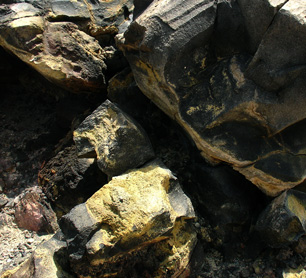Hydrogen Sulfide

Hydrogen sulfide deposits on volcanic rock.
Hydrogen sulfide (H2S) is a gas best known for giving water a “rotten egg” odor. The objectionable odor makes water unfit for drinking, household use, or industrial processes. It is difficult to test for in laboratories, since it dissipates quickly when exposed to air.
What is commonly called hydrogen sulfide actually results from a variety of causes. The most common explanation is that the smell is the result of the metabolism of bacteria which consume sulphur. It can also result from petroleum contamination of wells, especially natural gas.
Effects of Hydrogen Sulfide
Aside from its offensive odor, hydrogen sulfide can blacken plumbing fixtures and the fumes can even blacken painted surfaces.
Although hydrogen sulfide is a poisonous gas that can be deadly in large amounts, the health effects of the amounts typically detected in water are generally not of concern. According to the World Health Organization:
Although oral toxicity data are lacking, it is unlikely that anyone could consume a harmful dose of hydrogen sulfide in drinking-water.
Water Treatment for Hydrogen Sulfide
Treatment usually involves oxidizing the gas with the standard water treatment oxidants—chlorine, aeration (pressure tank style), hydrogen peroxide, ozone, potassium permanganate—then filtering out the oxidant and the remnant of the oxidation process, elemental sulphur. Hydrogen sulfide can also be treated by open tank aeration in which the contaminant is allowed to escape into the atmosphere.
If the problem is slight, carbon, especially catalytic carbon, can be used as a stand-alone treatment, but if the hydrogen sulfide is present in a significant amount, carbon filtration alone is insufficient.
The smell is often most prevalent in hot water, and it is sometimes treated by changing the sacrificial anode of the home's hot water heater.
Sources: World Health Organization, Photo: WikiMedia, author: Stan Zurek
Site Index
Filtration Systems
- Aeration for Iron & Sulfide
- Backwashing Filters
(whole house & well units)
- Chlorine & Chemical Injectors
- Countertop Water Filters
- Emergency Filters
- Garden Hose Filters
- Reverse Osmosis, Residential
- Reverse Osmosis, Commercial
- Shower Filters
- Specialty Filters
- Ultraviolet Systems
- Undersink Filters
- Water Softeners
- Whole House Filters
Cartridges
Parts
- Replacement Parts
- Faucets
- Filter Media
- Fittings
- Housings
- O-rings
- Pumps
- Pura UV
- R.O. Parts
- R.O. Tanks
- R.O. Booster Pump
- VIQUA UV